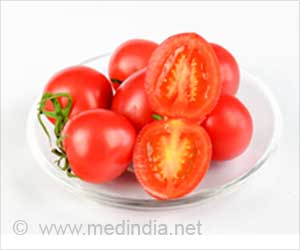- Genetically modified purple tomatoes have been cleared in a preliminary assessment with US regulators and are one step closer to getting into US stores
- These ‘super’ tomatoes have ten times as much of this antioxidant as regular tomatoes (which antioxidant??)
The purple tomatoes are the first to pass the new SECURE law in the US. Phased implementation of the SECURE Act happened between May 2020 and October 2021. The US Department of Agriculture's (USDA) new regulations updates how the government evaluates genetically modified foods. It puts more emphasis on the food itself than the method used to generate it.
Health Advantages of Purple Tomatoes
Purple tomatoes are not to be confused with tomatoes with purple skin only. They are purple on the interior and outside. The color and increased levels of anthocyanins are provided via genes derived from the purple snapdragon plant. According to Norfolk Plant Sciences, tomatoes offer additional health advantages because they have ten times as much of this antioxidant as regular tomatoes.The purple tomatoes also referred to as ‘super tomatoes’, can now be imported and transported over state lines. As soon as they gain final regulatory approval, the company intends to give seed packets to backyard gardeners.
Agrobacterium, a common agricultural bacterium, was utilized by Norfolk to transfer genetic alterations to the Micro-Tom tomato cultivar. The corporation then used cross-breeding to transfer the same alterations into other tomato types.
Some genetically modified organisms (GMOs) might be challenging to distinguish. Many are genetically altered, but these changes do not affect how they look. Many are altered to make them easier to ship or to last longer on shelves. On the other hand, Norfolk Plant Sciences' dark purple tomatoes will probably stick out in the produce section.
Increasing Food Innovation
“We are pleased that the USDA reviewed our bioengineered purple tomato and reached the decision that from a plant pest risk perspective, this plant may be safely grown and used in breeding in the United States,” says Nathan Pumplin, PhD, CEO of Norfolk Plant Science’s U.S.-based commercial arm. “This decision represents an important step to enable innovative scientists and small companies to develop and test new, safe products with consumers and farmers.”According to Andrew Walmsley, senior director for government affairs at the American Farm Bureau Federation, the new federal law was created to promote innovation while lowering pest threats.
“We have been genetically modifying plants and animals since we ceased being mostly hunters and gatherers,” Walmsley says. “Improved genetics provide a multitude of societal benefits including, but not limited to, more nutritious food.”
Health Concerns of Purple Tomatoes Put Forth by the Non-GMO Camp
These new tomatoes have not won over everyone.Hans Eisenbeis, director of mission and messaging at the non-GMO Project, a nonprofit organization in Bellingham, Washington, that verifies consumer products that do not contain GMO ingredients, responds to the question of what consumers should take into consideration by saying, “We want them to be aware that if this is a genetically modified product.”
“GMOs are pretty ubiquitous in our food system,” he says. “It’s important that [consumers] know this particular tomato is genetically engineered in case they are choosing to avoid GMOs.”
He claims that there are additional sources of anthocyanins, such as blueberries.
Eisenbeis believes that the SECURE legislation amendments 'deregulate' the use of genetically modified organisms (GMOs) in agriculture, which will make it harder for the USDA's Animal and Plant Health Inspection Service to control these goods.
One concern is that the same mechanism used to genetically modify this plant could be used for others and “open up the door potentially for genetic applications that are entirely unregulated,” Eisenbeis says. Acknowledging there are sceptics of GMO products, Pumplin says, “Skepticism can be a good start to learning when it is followed by gathering solid information. We encourage people to learn about the science-based facts of GMOs and the ways that GMOs can benefit consumers and the climate.”
“In addition, there are many non-GMO and Organic Certified products available on the market, and consumers who choose to avoid GMOs have many good choices,” Pumplin adds. “New products improved with biotechnology will offer extra choices to some consumers who are interested in the benefits.”
Are Purple Tomatoes Already on the Market
The SECURE rule’s first regulatory barrier has been cleared, but purple tomatoes have not yet begun to appear in supermarkets. Regulation from several federal agencies, such as the FDA, the EPA, and other USDA departments, may still be applicable. The Agriculture Marketing Service's label specifications for the tomatoes may need to be followed.A voluntary food and feed safety and nutritional assessment report were sent to the FDA by Norfolk Plant Sciences.
Time will tell if the purple tomato faces any other obstacles to forming a purple pyramid in your neighborhood vegetable section.
“We want to bring our tomatoes to market with care and without rushing them,” said Pumplin.
Source-Medindia
















